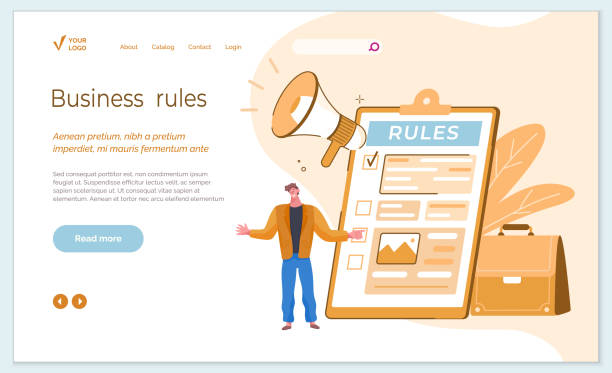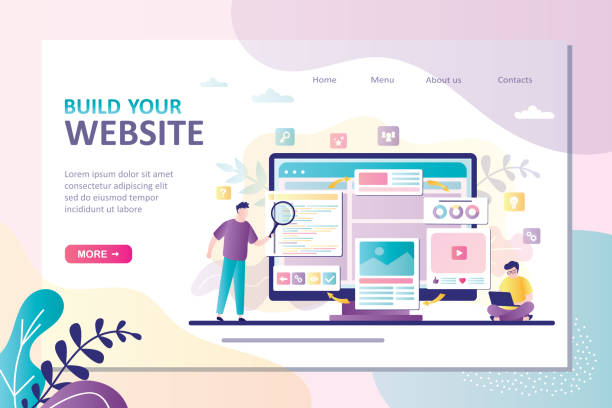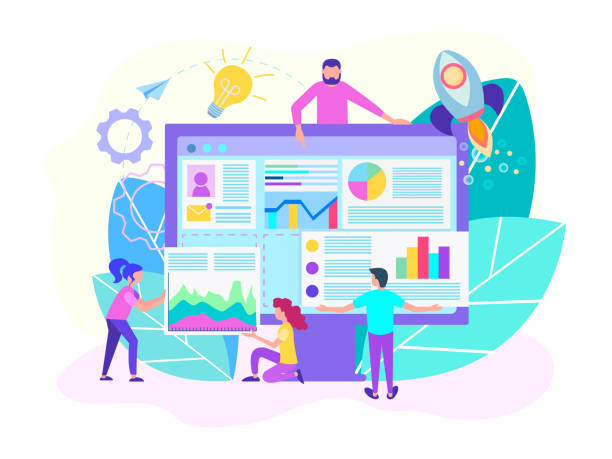Why is Multilingual Website Design a Necessity Today?

In today’s world, where geographical boundaries are blurred in the digital space, #multilingual_website_design is no longer a competitive advantage but a vital necessity for any business aspiring to expand its activities globally.
This approach allows you to connect with more audiences worldwide and convey your message in a language they understand.
Website design is not limited to displaying information; it involves establishing effective and deep communication with the user.
Many internet users prefer to read content in their native language, which can lead to increased conversion rates and customer loyalty.
This chapter provides an explanatory look at the importance and necessity of this step, explaining how a multilingual site can be a bridge between you and global markets.
Without access to different languages, you have overlooked a significant portion of your market potential.
Does your current website build the trust that potential customers should have in your business? If not, it’s time to get your professional and impactful corporate website with Rasavob.
✅ Fully custom design tailored to your brand identity
✅ Increased lead generation and business credibility in the eyes of customers⚡ Contact us for a free consultation!
Benefits of Multilingual Website Design for SEO and User Experience

One of the most important reasons to invest in multilingual website design is the significant improvement in SEO (Search Engine Optimization) and enhancement of user experience (UX).
From an SEO perspective, multilingual websites help search engines properly rank your content for users in different geographical regions.
Using hreflang tags and proper URL structuring, including subdomains or subfolders for each language, signals to search engines which version of the content is suitable for which language and target region.
This helps prevent duplicate content issues and increases your website’s visibility in search results.
From a user experience standpoint, access to content in their native language builds a sense of trust and comfort for users.
They can easily navigate the site, find the information they need, and interact with your business.
This positive user experience not only increases the time users spend on the site but also improves customer retention and conversion rates.
This chapter, with an educational approach, shows you how to maximize these benefits.
Challenges and Technical Considerations in Multilingual Website Design

Implementing a multilingual website can come with several technical challenges that require a specialized approach.
One of the most crucial decisions is choosing the appropriate URL structure: using subdomains (e.g., es.example.com), subfolders (e.g., example.com/es/), or top-level domains (e.g., example.es).
Each of these methods has its own advantages and disadvantages in terms of SEO, maintenance, and technical complexity.
Furthermore, your Content Management System (CMS) must be capable of managing multiple languages either natively or through powerful plugins.
Issues related to translating strings, images, and videos are also highly important.
You must ensure that all site elements, including error messages and forms, are correctly translated.
Choosing an appropriate translation tool (manual, machine, or hybrid) and managing the translation process are also crucial.
This section details these challenges and provides solutions to overcome them.
One of the key decisions in multilingual website design is choosing the appropriate architectural model for content management.
There are two main approaches for storing and presenting multilingual content: the ‘Integrated Model,’ where all languages are managed within a single database and CMS, and the ‘Separate Model,’ where each language has an independent CMS installation and database.
Each of these models has its own advantages and disadvantages, presented comparatively in the table below:
| Feature | Integrated Model | Separate Model |
|---|---|---|
| Content Management | Centralized and easier for coordination | Decentralized, requiring more manual coordination |
| Initial Development Cost | Higher, due to initial complexity | Lower, a new site for each language |
| Maintenance and Updates | Easier, integrated changes | More complex, requiring multiple updates |
| Flexibility | Less in language-by-language customization | More in customizing each language |
| SEO | More complex in managing hreflang and URL structure | Simpler in managing URL structure, but requires separate domain authority |
Choosing the Right Approach for Multilingual Implementation
![]()
Choosing the right approach for multilingual website development is one of the key decisions that directly impacts SEO, maintenance, and user experience.
There are three main methods for organizing URL structure for multilingual sites: Country Code Top-Level Domains (ccTLDs), Subdirectories, and Subdomains.
Each of these methods has its own advantages and disadvantages that must be chosen based on your business objectives, budget, and technical resources.
ccTLDs (e.g., example.fr for France) provide the strongest signal to search engines for geographical targeting but involve higher management and costs.
Subdirectories (e.g., example.com/fr/) are very popular for SEO as they share the main domain’s authority and are relatively easier to manage.
Subdomains (e.g., fr.example.com) are another option that can operate more independently technically but may receive less authority from the main domain.
This chapter offers a comprehensive guide to choosing the best approach for you, with an in-depth review of each option and its impact on various aspects of the website.
Tired of losing customers due to poor e-commerce website design? With Rasavob, solve this problem once and for all!
✅ Increase sales and visitor-to-customer conversion rates
✅ Smooth and engaging user experience for your customers⚡ Get a free consultation
Content Translation Strategies and Quality Assurance
![]()
Content translation goes beyond merely converting words from one language to another; it’s an analytical and creative process that requires a deep understanding of cultural differences and linguistic nuances.
To achieve a successful multilingual website implementation, choosing the right translation strategy is crucial.
Do you use machine translation (like Google Translate) for large volumes of content and lower costs? Or will you rely on human and specialized translation for sensitive and marketing content? Many companies employ a hybrid approach, where machine translation is used as a base and then edited and improved by human translators.
Ensuring translation quality is also of paramount importance.
Translation errors can damage your brand’s credibility and disrupt the user experience.
Using thorough reviews, specialized glossaries, and Translation Management Systems (TMS) can help maintain content consistency and quality across all languages.
This chapter examines various translation methods and key tips for quality assurance.
Best Practices for UX and UI in Multilingual Websites

User Interface (UI) and User Experience (UX) design in multilingual website structures must enable users to easily access their desired language and navigate the site without issues.
This section, presented in an engaging yet highly practical manner, introduces you to the best practices in this area.
Appropriate placement for language selection (usually in the header or footer), using flag icons (with caution, as they may not always be accurate and some countries have multiple official languages) or full language names, and the ability to automatically detect the user’s language based on IP or browser settings are important considerations.
Ensure that your Responsive Design works well in all languages and that translated texts do not disrupt the layout.
Additionally, text direction (for languages like Persian and Arabic, which are read from right-to-left) must be correctly implemented.
Attention to fonts and typography is also essential, as some fonts may not support specific characters of certain languages.
A smooth and localized user experience can significantly impact conversion rates and customer satisfaction.
SEO Optimization for Multilingual Websites

Search Engine Optimization (SEO) for a multilingual website is more complex than for a single-language site and requires a specialized and precise approach.
Multilingual website design cannot achieve its global goals without a proper SEO strategy.
One of the most important elements is the correct use of the hreflang tag.
This tag tells search engines like Google which version of the page is appropriate for which language and geographical region, preventing duplicate content issues.
Incorrect hreflang implementation can harm a site’s SEO instead of helping it.
Furthermore, keyword research should be performed separately for each language and region, as keywords and search phrases may differ across cultures.
The sitemap must include all URLs for different languages.
Additionally, site loading speed, image optimization, and internal link structure must be reviewed and optimized for each language version.
This chapter comprehensively covers multilingual SEO strategies and their technical aspects to ensure your website shines in international markets.
To ensure your multilingual website is properly indexed and ranked by search engines, special attention must be paid to key SEO elements.
The table below illustrates the most important multilingual SEO elements and their associated tips:
| SEO Element | Description and Tips |
|---|---|
| Hreflang Tag | Helps search engines show the correct page version to users with different languages. Essential for preventing duplicate content. |
| Keyword Research | Should be performed separately for each language and region; keywords can be cultural. |
| URL Structure | Correct selection of subdomains, subfolders, or ccTLDs for geographical signaling. |
| XML Sitemap | Must include all URLs for different languages and their respective hreflang tags. |
| Localized Content | Content should not only be translated but also localized to match the target culture. |
| Site Speed and Hosting | Servers close to target audiences can increase loading speed. |
Practical Tools and Platforms for Multilingual Website Design

Today, numerous tools and platforms exist to facilitate multilingual website design.
From powerful Content Management Systems (CMS) to specialized plugins and automated translation services, a wide range of options are available.
This chapter, with a news-oriented approach, introduces some of these tools.
For example, WordPress, with plugins like WPML or Polylang, easily allows for the creation of multilingual sites.
For e-commerce platforms, Shopify and Magento also have built-in multilingual capabilities or through plugins.
Translation Management Systems (TMS) such as Smartling or Transifex also greatly assist in managing the translation process, ensuring quality, and fostering collaboration among translation teams.
Furthermore, SEO tools like SEMrush or Ahrefs offer functionalities for multilingual keyword research and competitor analysis in international markets.
Choosing the right tools depends on your project’s complexity, budget, and team’s experience, but using these tools can significantly simplify the development and maintenance process of a multilingual website.
Did you know that 94% of users’ first impressions of a business are related to its website design? With a professional corporate website design by **Rasavob**, transform this initial impression into an opportunity for growth.
✅ Attract more customers and increase sales
✅ Build credibility and trust in the audience’s eyes⚡ Get a free website design consultation!
Common Mistakes in Multilingual Website Design and Solutions

While multilingual website design offers numerous advantages, there are also common mistakes that can undermine your efforts.
This section, presented as thought-provoking content, addresses these errors and offers solutions for them.
One of the biggest mistakes is literal translation instead of content localization.
Localization means adapting content to local culture and customs, which includes idioms, units of measurement, dates, and even colors.
Another mistake is neglecting multilingual SEO and improper use of hreflang tags, which can lead to search engine penalties for duplicate content.
Failing to provide a clear and accessible language selection option for users, or automatic language detection without the possibility of changing it, are also common UX errors.
Furthermore, teams might only translate text and fail to localize images, videos, and multimedia content.
Insufficient testing of the website in different languages and on various devices can also lead to functional problems.
By being aware of these mistakes and adopting a preventive approach, you can ensure the success of your multilingual project.
The Future of Multilingual Website Design and Conclusion

The future of multilingual website design is increasingly moving towards personalization and artificial intelligence.
With technological advancements, we will witness higher quality machine translations and smarter localizations, which will further improve the user experience.
The use of AI to analyze user behavior in different languages and provide relevant and targeted content is one of the key trends for the future.
This section analytically explores these future trends.
The development of voice capabilities and voice-based interactions in various languages will also gain increasing importance.
Ultimately, multilingual website design is not just an investment in technology but a strategic investment in market expansion, increased brand awareness, and building meaningful connections with global audiences.
By adhering to the principles and best practices outlined in this article, businesses can open the doors to global markets and move towards sustainable and comprehensive growth.
The importance of this approach will become increasingly prominent in today’s digital world, where global communication is paramount.
Frequently Asked Questions
| Question | Answer |
|---|---|
| What is a multilingual site? | A website whose content is available to users in more than one language. |
| Why should I make my site multilingual? | To reach more audiences in global markets, improve user experience, and boost international SEO. |
| What are the technical approaches to building a multilingual site? | Using subdirectories, subdomains, or URL parameters to differentiate languages. |
| How does multilingual design affect SEO? | By targeting local keywords and providing content in users’ native languages, the site’s ranking in search engines for those regions improves. |
| What are the challenges of multilingual website design? | Content translation management, support for Right-to-Left (RTL) direction, technical issues related to language addressing, and maintaining design consistency. |
| How to choose languages for a multilingual site? | Based on target audience analysis, desired markets, and current site traffic data (if available). |
| What is RTL support and why is it important for some languages? | Right-to-Left, the direction of text and page elements from right to left, which is essential for languages like Persian, Arabic, and Hebrew. |
| How to manage multilingual site content? | Using Content Management Systems (CMS) with multilingual capabilities, translation plugins, or professional translation services. |
| How is User Experience (UX) in a multilingual site? | It must be easy to change the language, and the translated content must be of high quality so that users feel comfortable. |
| What are common CMS platforms for multilingual sites? | WordPress (with plugins like WPML), Joomla, Drupal, and Shopify (with relevant settings or plugins). |
And other services of RasaWeb Advertising Agency in the field of advertising
Smart SEO: A professional solution for increasing sales with a focus on precise audience targeting.
Smart Digital Advertising: A novel service for increasing click-through rates by optimizing key pages.
Smart Marketing Automation: An effective tool for improving SEO rankings with the help of Google Ads management.
Smart Sales Automation: An effective tool for online growth by customizing user experience.
Smart Link Building: An effective tool for increasing sales by optimizing key pages.
And over hundreds of other services in internet advertising, advertising consultation, and organizational solutions
Internet Advertising | Advertising Strategy | Advertorial
Sources
Comprehensive Guide to Multilingual Website Design on VirgulGlobal Business Expansion Strategies at RayamarketingSearch Engine Optimization for Multilingual WebsitesWhat is a Multilingual Website and What are its Benefits?
? To elevate your business in the digital world, Rasavob Afarin is with you. We help your brand grow and gain visibility by providing innovative solutions in digital marketing. For more information about personal website design and our other services, contact our experts today.
📍 Tehran, Mirdamad Street, next to Bank Markazi, Kazeroon South Alley, Ramin Alley, No. 6

